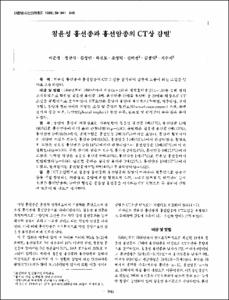침윤성 흉선종과 흉선암종의 CT상 감별
- Keimyung Author(s)
- Kim, Jung Sik; Suh, Soo Jhi
- Department
- Dept. of Radiology (영상의학)
- Journal Title
- 대한방사선의학회지
- Issued Date
- 1998
- Volume
- 39
- Issue
- 5
- Abstract
- Purpose: In order to determine the differential points between them, we analyzed the CT findings of invasivethymoma and thymic carcinoma. Materials and Methods: We retrospectively reviewed the CT scans of 14 patients withinvasive thymoma and 15 with thymic carcinoma, confirmed by surgery(n=19) or percutaneous needle aspiration (n=10)between 1988 and 1996. CT findings were evaluated in each group for intrathoracic spread (posterior, directposterior, and anterolateral), obliteration of the fat plane between the mass and vascular structures, vesselencasement, invasion of adjacent mediastinal structures, pleural implants, mediastinal nodes and distantmetastasis. Results: Direct posterior spread was more common in thymic carcinoma than invasive thymoma ; it wasseen in one case (7%) of invasive thymoma and 12(80%) of thymic carcinoma(p=0.00). Posterior spread was seen insix cases (43%) of invasive thymoma and nine (60%) of thymic carcinoma. Anterolateral spread was seen only in twocases (13%) of thymic carcinoma. Obliteration of the fat plane was seen in nine cases (64%) of invasive thymomaand 14 (93%) of thymic carcinoma, while vessel encasement was seen in two cases (14%) of invasive thymoma and13(87%) of thymic carcinoma(p=0.00). Invasion of adjacent structures was seen in two cases (14%) of invasivethymoma and eight (53%) of thymic carcinoma. Pleural implants were more common in invasive thymoma than thymiccarcinoma, being seen in six cases (43%) of the former and one (7%) of the latter(p=0.04). Mediastinallymphadenopathy was seen in three cases (21%) of invasive thymoma and ten (67%) of thymic carcinoma. Distantmetastases were observed only in six cases (40%) of thymic carcinoma(p=0.02). Conclusion: Althoughdifferentiation between invasive thymoma and thymic carcinoma is difficult on the basis of CT findings, there arecertain differential points. Thymic carcinomas showed a higher rate of direct posterior intrathoracic spread,vessel encasement, mediastinal nodes and distant metastases than invasive thymomas. These, however, were morecommonly associated with pleural implants than were thymic carcinoma.
목적 : 침윤성 흉선종과 흉선암종의 CT 소견을 분석하여 감별에 도움이 되는 소견을 알아보고자 하였다.
대상 및 방법 : 1988년부터 1996년까지 수술(n=19)과 세침흡인생검(n=10)을 통해 병리조직학적으로 확진된 침윤성 흉선종 14예, 흉선암종 15예를 포함한 총 29예를 대상으로 CT소견을 후향적으로 분석하였다. CT소견은 종양의 흉강내 확산경로(후방형, 직후방형, 전외측형), 종양과 혈관사이의 지방면 소실 및 종양의 혈관포위(vessel encasement) 소견, 주변 장기의 침습 여부, 늑막반(pleural implant) 형성 유무, 림프절 및 원격전이 유무 등을 분석하였다.
결과 : 종양의 흉강내 파급경로는 직후방형이 침윤성 흉선종 1예(7%), 흉선암종 12예(80%)로 흉선암종에서 더 흔히 관찰되었다(p=0.00). 후방형은 침윤성 흉선종 6예(43%), 흉선암종 9예(60%)에서, 전외측형은 흉선암종 2예(13%)에서만 보였다. 종양과 혈관사이의 지방면 소실은 침윤성 흉선종 9예(64%), 흉선암종 14예(93%)에서 관찰되었다. 혈관포의 지방면 소실은 침윤성 흉선종은 2예(14%)에서만 관찰되었으나 흉선암종은 13예(87%)에서 관찰되었다(p=0.00). 주변 장기의 침습은 침윤성 흉선종 2예(14%), 흉선암종 8예(53%)에서 보였다. 늑막반 형성은 침윤성 흉선종 6예(43%), 흉선암종 1예(7%)로 침윤성 흉선종에서 빈번하였다(p=0.04). 림프절 종대는 침윤성 흉선종 3예(21%), 흉선암종 10예(67%)에서 보였고, 원격전이는 흉선암종에서만 6예(40%) 관찰되었다(p=0.02).
결론 : CT소견만으로 침윤성 흉선종과 흉선암종의 감별이 어려우나 직후방으로 중종격동을 직접 침범하는 파급경로, 종양에 의한 혈관포위 소견, 그리고 림프절 및 원격전이 등의 소견은 흉선암종을, 늑막반 형성은 침윤성 흉선종을 시사하는 CT 소견으로 두 질환의 감별에 도움이 될 것으로 생각한다.
- Alternative Title
- CT Differentiation of Invasive thymoma and Thymic carcinoma.
- Publisher
- School of Medicine
- Citation
- 이은정 et al. (1998). 침윤성 흉선종과 흉선암종의 CT상 감별. 대한방사선의학회지, 39(5), 941–946.
- Type
- Article
- ISSN
- 0301-2867
- Appears in Collections:
- 1. School of Medicine (의과대학) > Dept. of Radiology (영상의학)
- 파일 목록
-
-
Download
 oak-bbb-1032.pdf
기타 데이터 / 502.87 kB / Adobe PDF
oak-bbb-1032.pdf
기타 데이터 / 502.87 kB / Adobe PDF
-
Items in Repository are protected by copyright, with all rights reserved, unless otherwise indicated.